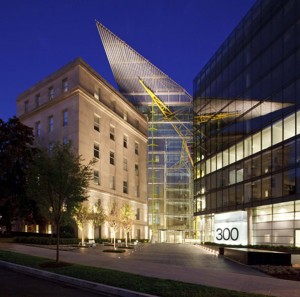I was recently asked by the chairman of a real estate company that manages a 4.5 million-square-foot portfolio of retail, office, and industrial properties, if I could recommend a firm to design a new office complex. He wanted a cut above the run-of-the-mill. Running names through my head, I found that almost all of the architects that my Ivy League colleagues and their students admire, the academic A-list so to speak, lack the experience and the staff to tackle a large commercial project. Their reputations are based on institutional rather than commercial projects, campus buildings, museums, and libraries, not on office buildings and shopping malls. While some condo developers did hire boutique firms to produce unusual designs during the last real estate boom, I’m not sure that’s what was required here. “I want my architect to have already made all his mistakes,” a developer friend once told me.

300 New Jersey Avenue, Washington, D.C.
Another alternative is the very large national firms that have branch offices all over the country, and the manpower to tackle any sort of project. Office size is not necessarily a deterrent to quality. A hundred years ago, the best large firms such as McKim, Mead & White, Warren & Wetmore, and Graham, Anderson, Probst & White, capably designed all sorts of buildings—residences, libraries, railroad stations, hotels, apartments, and offices. However, the current large firms resemble architectural widget factories, and can be counted on to produce work that is predictable, glib, and formulaic, without architectural character or conviction. It is unclear to me what is driving this situation. Do the developers demand banal design, or is that what their architects deliver? A spate of well-designed commercial buildings such as 300 New Jersey Avenue, a Washington,D.C. office complex (Rogers Stirk Harbour), the New York Times Building (Renzo Piano Building Workshop), and Tower 4 at the World Trade Center (Maki & Associates)—all designed by foreigners, by the way—suggest that it may be the latter.

